
International Journal of Applied Chemistry.
ISSN 0973-1792 Volume 13, Number 1 (2017) pp. 29-52
© Research India Publications
http://www.ripublication.com
Fly ash in India: Generation vis-à-vis Utilization and
Global perspective
Surabhi
Department of Applied Chemistry, Pillai College of Engineering,
University of Mumbai, Mumbai, 410206, India.
Abstract
Global energy demand is set to increase by almost 50% in the period 2016 to
2040. Much of this growth will continue to be concentrated in the developing
world, primarily China and India, as industrialization, population growth and
the unprecedented expansion of the middle class will propel the need for
energy in general and coal, in particular. The Indian coal is of low grade
having high ash content of the order of 30 - 45% producing large quantity of
fly ash at coal/lignite based thermal power stations in the country. The
management of fly ash has been troublesome in view of its disposal because of
its potential of causing pollution of air and water. In this paper, the nature of
Indian fly-ash and its various utilizations have been described. In the past
decade, there has been tremendous increase in the generation of fly-ash since
more than 70% of country’s demand for electricity is met by coal-based thermal
power plants. At present, India produces approximately 180 million-tons of
fly-ash. The disposal of such huge quantity of ash is a serious issue.This paper
also gives an overview of global scenario of fly ash generation and its utilization
apart from India.
Keywords: Fly ash; Coal; Cement; Concrete; MoEFCC; Thermal Power Plants;
Generation; Energy; Utilisation
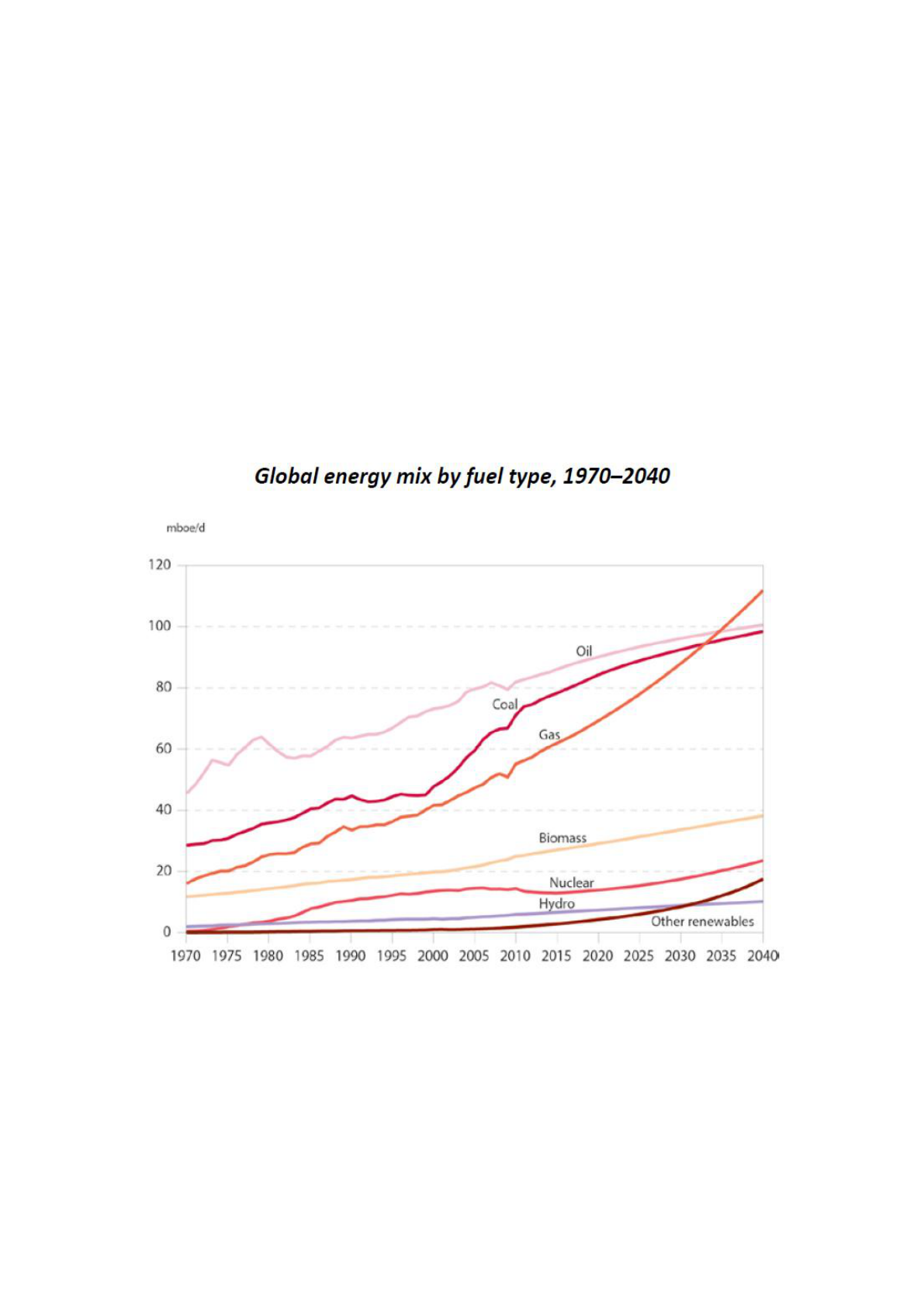
30 Surabhi
INTRODUCTION
As an essential ingredient for growth and development, energy has become the
driving force of the modern economy. Since the 1970s, traditional fossil fuels have
been the dominant energy source (Figure 1). Oil, the leading energy source in 1970,
made up 43% of total energy demand, while the shares of coal and natural gas were at
27% and 15%, respectively. By 2016, however, these figures had shifted somewhat.
The share of natural gas had increased to 22%, while that of oil had dropped to 32%.
However, Coal’s share remained roughly dominant over the period.
Figure 1: Global Energy mix by fuel type, 1970- 2040 [1]
Coal being abundantly available worldwide, therefore, has been major source of
energy and expected to remain so in future. In order to produce energy, pulverized
coal is generally burned. During combustion, the volatile matter and carbon is burn

Fly ash in India: Generation vis-à-vis Utilization and Global perspective 31
off and the coal impurities such as clays, shale, quartz, feldspar etc. mostly fuse and
remain in suspension[2]. These fused particles are passed along with flue gas. As the
flue gas approaches the low temperature zone, the fused substances coagulate to form
mainly spherical particles which are called fly ash. The remaining matter which
agglomerate and settle down at the bottom of furnace are called bottom ash. The
distribution of bottom ash and ESP ash is 20% and 80% respectively.
Fly ash was used to build Roman Colosseum, a 2000 year old structure which still
stands the test of time; is a classic example to know its existence. People used ash
generated from volcanoes in the construction of many roman structures. Volcanic ash
is the same as fly ash, the only difference is fly ash is generated artificially through
coal.
Fly ash is defined as per Cement & concrete terminology[3], “Finely divided residue
resulting from the combustion of ground or powdered coal which is transported from
the fire box through the boiler by flue gases”.
Fly ash is captured by mechanical separators, electrostatic precipitators or bag fillers.
ASTM C-618[4] categorizes coal combustion fly ash into two classes- Class F &
Class C. The Class F fly ash are normally generated due to combustion of anthracite
or bituminous coal and Class C is obtained by the burning of lignite or
sub-bituminous coal combustion.Class C fly ash possess CaO in excess (10-40%)
while Class F contains CaO less than 10%. Due to higher CaO content, Class C fly
ash participate both in cementitious and pozzolanic reaction whereas class F fly ashes
mostly contribute in pozzolanic reaction during hydration process.
Apart from chemical properties, physical properties of fly ash also play an important
role in cement. Physical properties of fly ash improve the microstructure and rheology
of concrete. Fly ash cannot react with water. It requires free lime which is formed on
hydration of Portland cement. This enables to trigger off its pozzolanic effect. It leads
to a longer life for concrete structure. For instance, Ghatghar Dam in India is a classic
example which is constructed using fly ash and the tallest building in the world - Burj
Khalifa in Dubai is another structure constructed using fly ash.
The benefits of fly ash include: delay the heat of hydration which helps in reduction
of thermal cracks in concrete; improves the workability of concrete and enhances the
life of structures and buildings among others [5]. The fly ash market are growing day
by day because of urbanization in emerging economies and increasing constructional
activities internationally. The beneficial properties of fly ash have attracted the
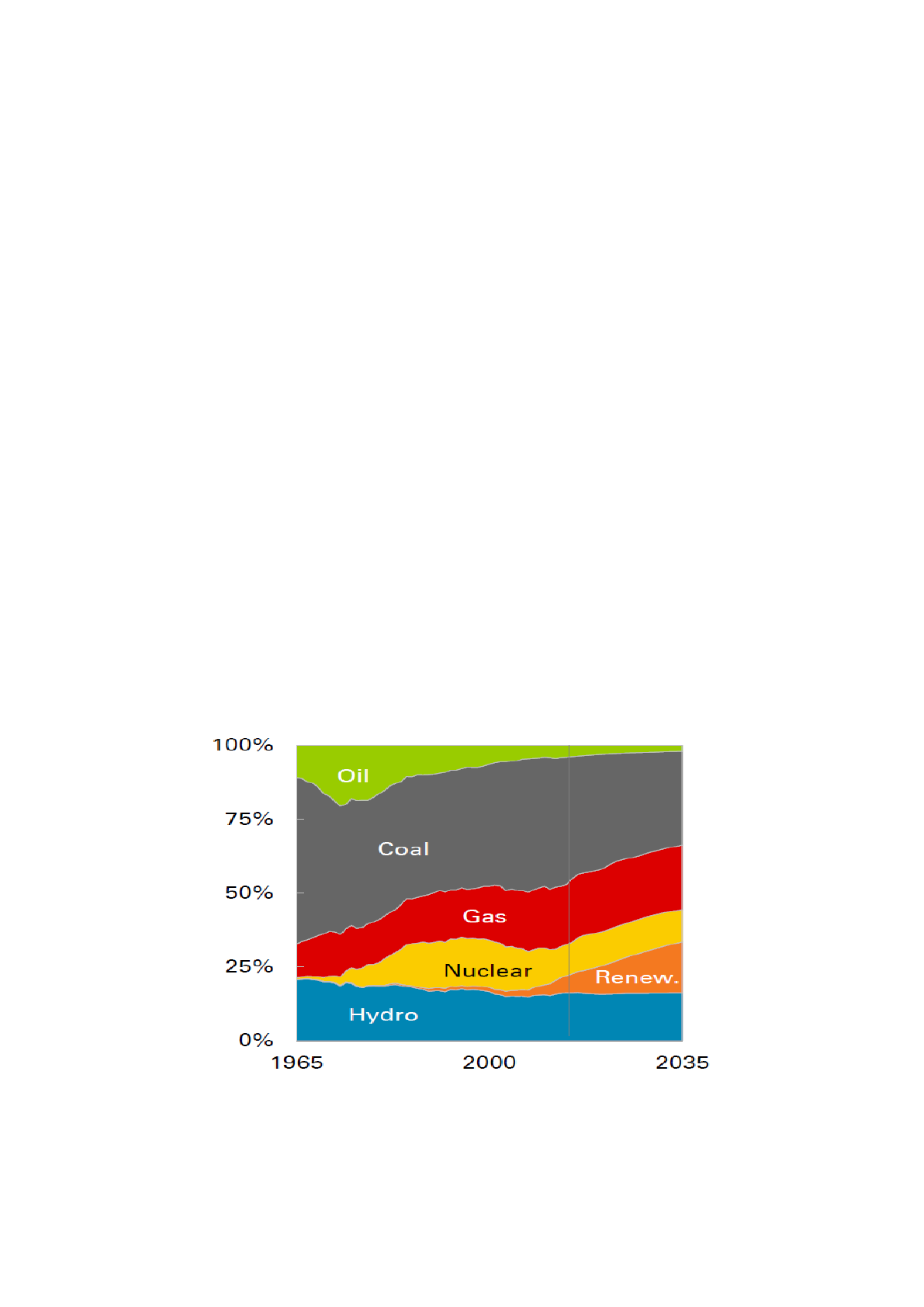
32 Surabhi
construction sector worldwide as fly ash has best suited the requirement for various
infrastructure projects.
The durability of concrete is directly affected by its permeability. Permeability is
defined as the property that governs the rate of flow of a fluid into a porous solid.The
major reasons for permeability of concrete are nature of hardened cement and
inter-connectivity of pores in the cement [6]. Poor quality of fly ash is responsible for
high permeability of concrete which is a major threat for the demand and growth of
global fly ash market.
In addition, fly ash has been proven to be the green building material due to
environmental benefits that it offers. Hence, the global fly ash market is anticipated to
experience high demand in the market during the forecast period from 2016-2022.
GLOBAL SCENARIO
Coal is the most abundant fossil fuel on the planet. It is a relatively cheap fuel, with
some of the largest deposits in regions that are relatively stable politically, such as
China, India and the United States. In last half century, coal has been a dominant
player in energy generation world-wide (Figure 2) and is projected to maintain it’s
dominance in decades to come.
Figure 2: Fuel-mix in global generation of energy [1]
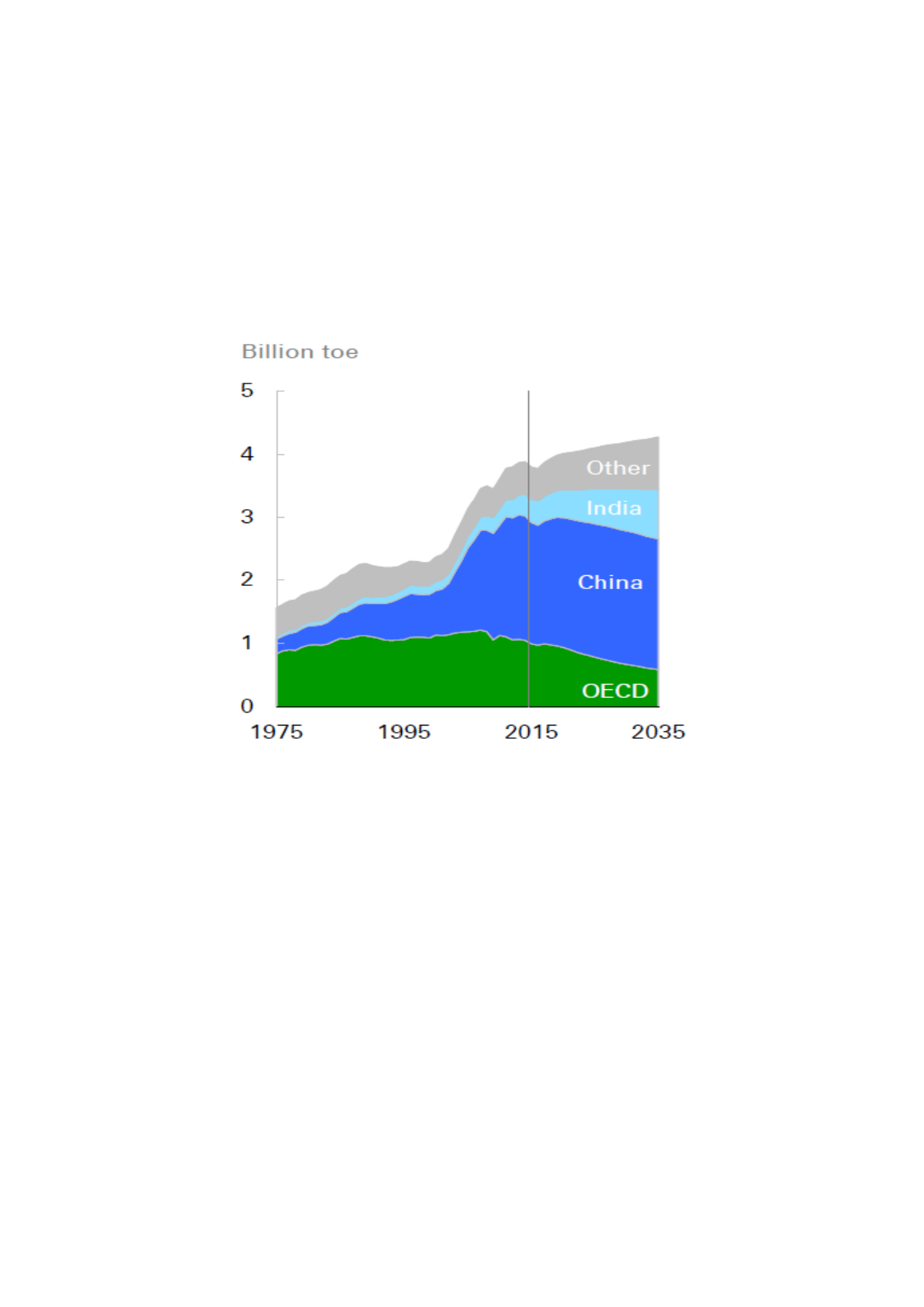
Fly ash in India: Generation vis-à-vis Utilization and Global perspective 33
China remains the world’s largest coal market, consuming almost half of global coal
supplies in 2035 (Figure 3). India shows the largest growth in coal consumption (435
M ton), overtaking the US to become the world’s second biggest consumer of coal.
Over two-thirds of India’s increased coal demand feeds into the power sector.
Figure 3: Regional break-up of Coal consumption [1]
During the last few decades, there has been a dramatic increase in coal ash production
in the world due to increased amounts of energy being generated by coal-fired power
plants. A number of researchers [7,8,9], have compiled extensive data on production
and utilization of coal ash in the world. The countries which are marching toward
rapid industrialization, such as China, and India, are showing increasing demand for
coal.
Asia Pacific accounted for larger share of global fly ash market in 2015. Growing
urbanization in and growing population in the region have led to increasing demand
for constructional activities. Improvement in the road constructions and steps adopted
for ease in transport through building highways, etc has also led to high demand for
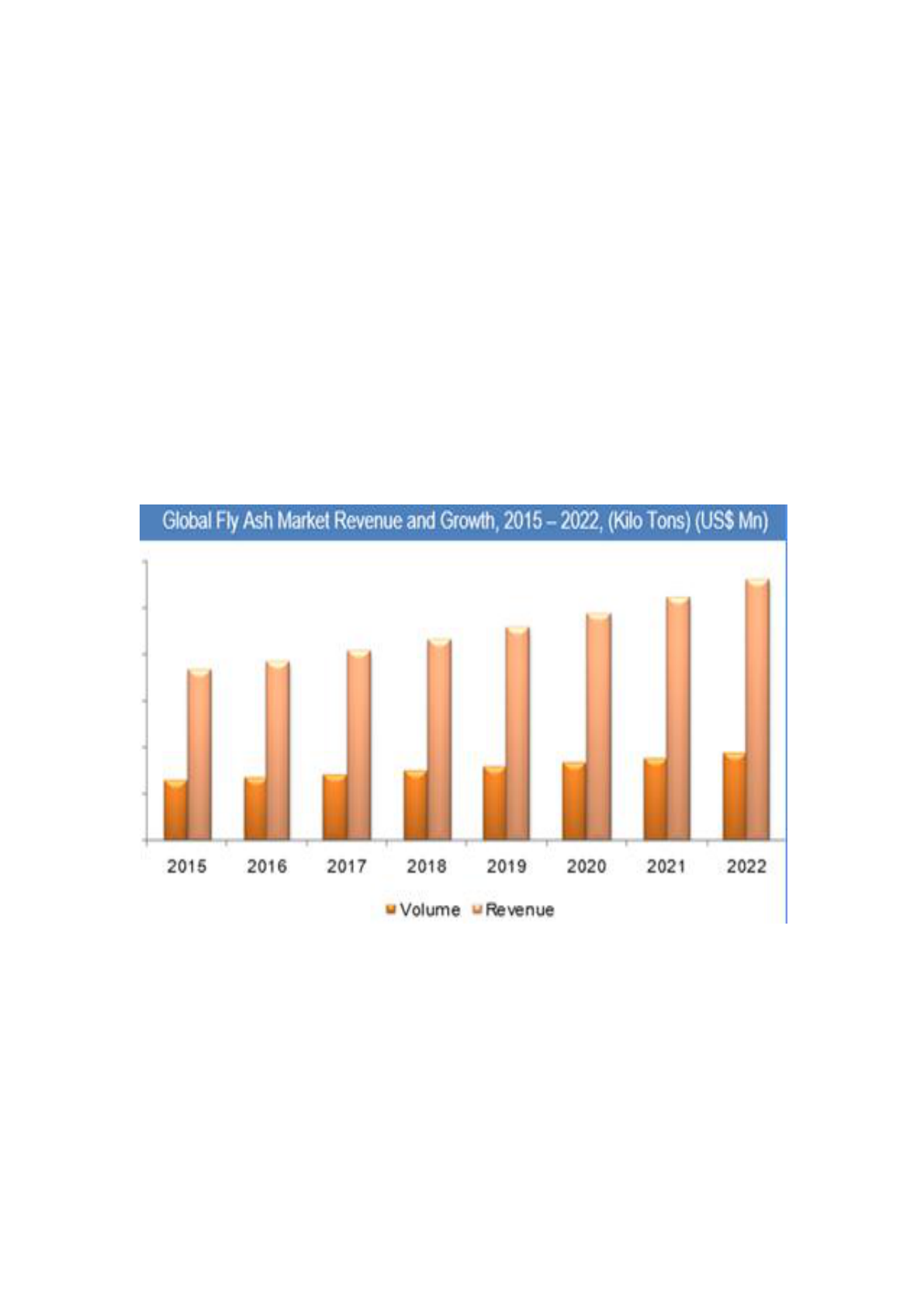
34 Surabhi
fly ash thereby promoting growth of global fly ash market. Increasing demand from
building and construction industry in North America is also expected to boost growth
of fly ash market. Europe is projected to fuel demand for fly ash due to environmental
measures adopted in the region. Middle East and Africa and Rest of the World
demonstrated steady growth for fly ash in the year 2015 but are anticipated to
augment during the forecast period. Hence, fly ash market is expected to experience
strong demand from several countries to meet the needs of the constructional sector
worldwide.
Fly Ash market was valued at US$ 39,548.1 Mn in 2015 and is expected to reach
US$ 64,761.9 Mn by 2022, growing at a CAGR of 7.3% during the forecast period
2016-2022 (Figure 4).
Figure 4: Global Fly Ash Market Revenue and Growth
Cement concrete technologies have been going through immense evolutionary
changes. Apart from factors such as strength, economy and durability are also playing
an important role globally. Initially, cement did not possess properties of strength and
durability, therefore, to make concrete durable and strong, cementious material such
as fly ash was started as a practice which is now used on a large scale worldwide.

Fly ash in India: Generation vis-à-vis Utilization and Global perspective 35
Portland cement accounted for the largest share of global fly ash market in 2015 and
is expected to retain its position during the forecast period from 2016 to 2022.
Figure 5: Global Fly Ash market revenue by application ( USD Bn )
Portland cement was the leading end use application of fly ash in 2015, accounting for
more than 26% of market revenue. The benefits of fly ash make it an essential
element to be used in Portland cement, road constructions and fire bricks. Portland
cement is expected to retain its position in the near future due to the strong demand
from the construction industry globally. Growing preference for greener substitutes is
another major driving factor for global fly ash market as fly ash contributes to
maintain pollution free environment. Road constructions and fire bricks are also
expected to follow the growth patterns of Portland cement in terms of demand in the
near future because of urbanization. Fly ash in form of concrete and fire bricks has
proven to be the best concrete in term of strength. Decorative glass, agriculture and
other applications are also projected to show steady growth in the near future. Hence,
rising demand for fly ash from speckled industries is expected to offer growth
opportunities for fly ash during the forecast period from 2016 to 2022.
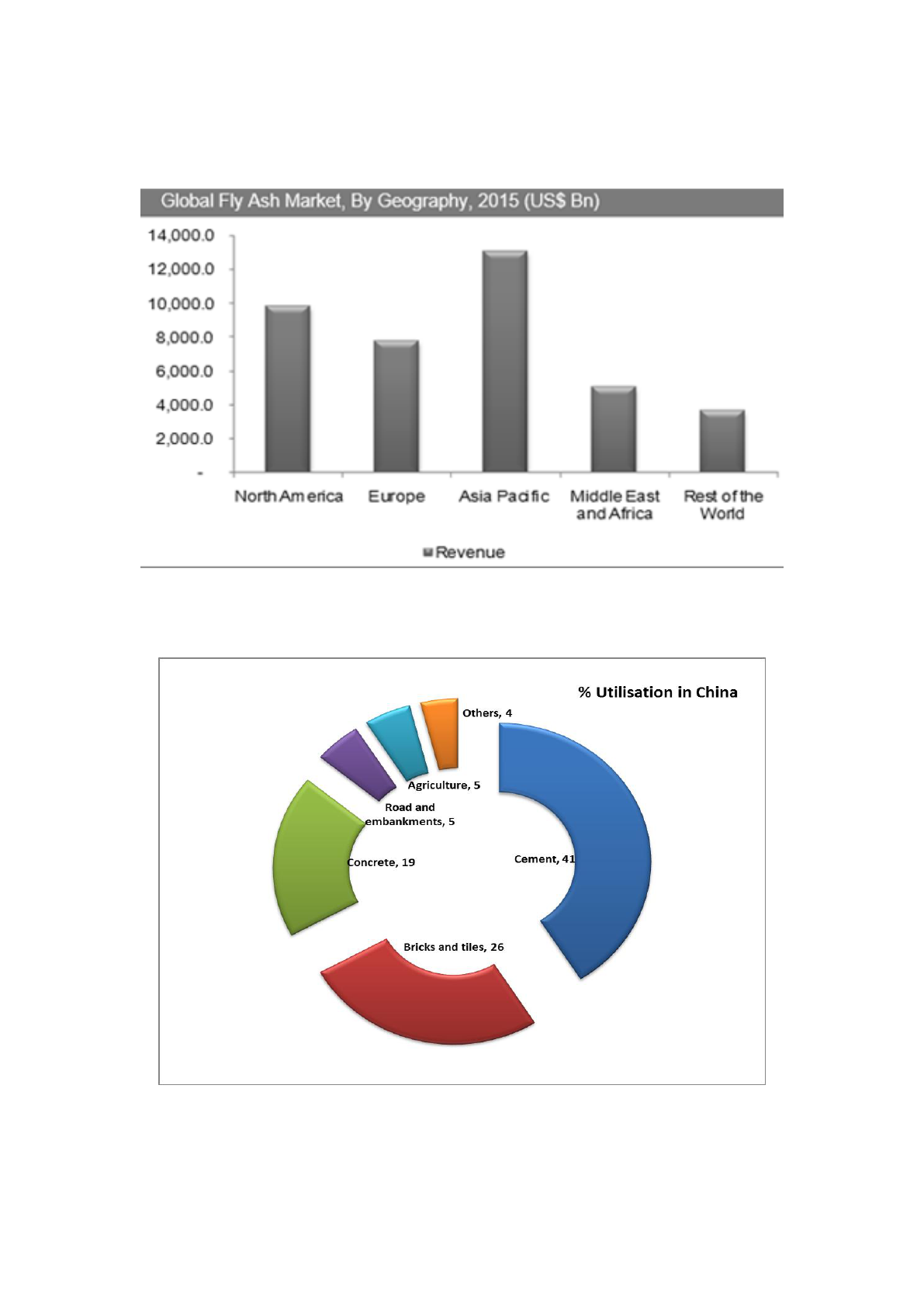
36 Surabhi
Figure 6: Global Fly Ash Market by Geography
Figure 7: Utilization of Fly Ash in China [10]
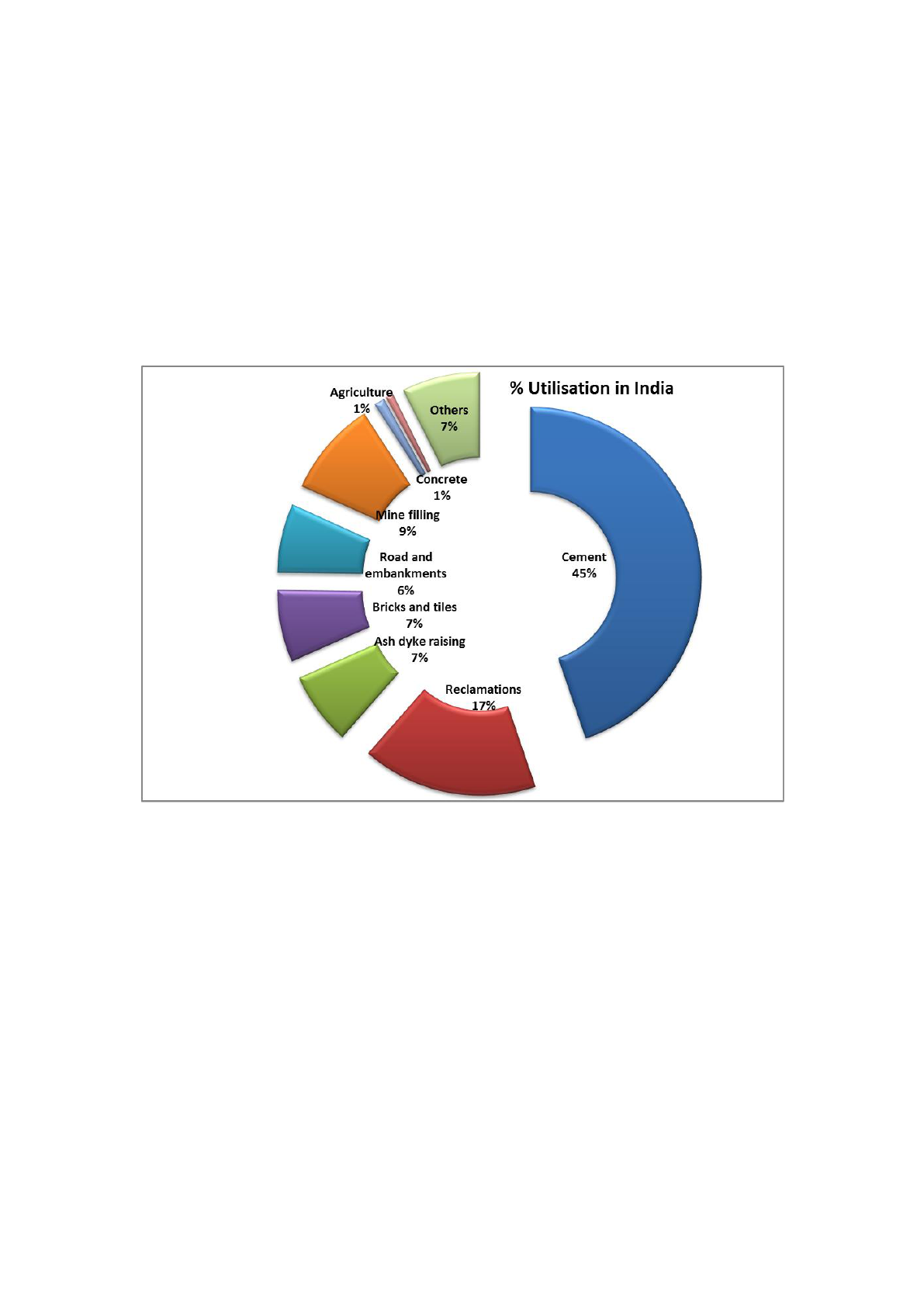
Fly ash in India: Generation vis-à-vis Utilization and Global perspective 37
According to the annual report of China comprehensive resource utilization (2012)
released by the National Development and Reform Commission (NDRC) of China,
the coal fly ash generation and utilization were 540 and 367 million tonnes in 2011
respectively. The utilization rate reached 67.96%, higher than that for the US
(46.74%) and India(55.79%). Among the section of utilization, the top 3 were
cement(41%), brick and tiles (26%) and concrete (19%) (Figure 7).
Figure 8: Utilization of Fly Ash in India [10]
The generation of fly ash in India has increased from 68.88 million tonnes in 1996–97
to 163.56 million tonnes in 2012–13, of which only 100.37million tonnes was
utilized. India has achieved a tremendous increase in its utilization from 9.63% in
1996–97 to 61.37% in 2012–13. However, nearly 40% of the ash is still unused.

38 Surabhi
ASH GENERATION & UTILIZATION IN INDIA
Coal/Lignite based Thermal Power Generation has been the backbone of power
capacity addition in the country. Indian coal is of low grade with ash content of the
order of 30-45 % in comparison to imported coals which have low ash content of the
order of 10-15%. Several no. of Coal/Lignite based thermal power plant is setup for
providing electric power to rapidly growing industrial as well as agriculture sectors.
In which 70 percent of the electricity generated is from coal based thermal plant. In
order to achieve the India economic growth of 8-9 percent, the country’s total coal
demand, has been forecast to increase ~ 730 Million tons in 2010-11 to ~2000 Million
tons in 2031-32 of this approx. 75 percent of this coal would go thermal power plant
[11].
Large quantity of ash is, thus being generated at coal/lignite based thermal Power
Stations in the country, which not only requires large area of precious land for its
disposal but is also one of the sources of pollution of both air and water.
Following graph is showing the production of fly ash samples from coal year wise in
India.
Figure 9: Generation of Fly Ash in India
To reduce the problem caused by production of fly ash, it is now mandatory to use fly
ash based products in all government schemes or programmes. Figure 10 shows the
fly ash mission project sites.
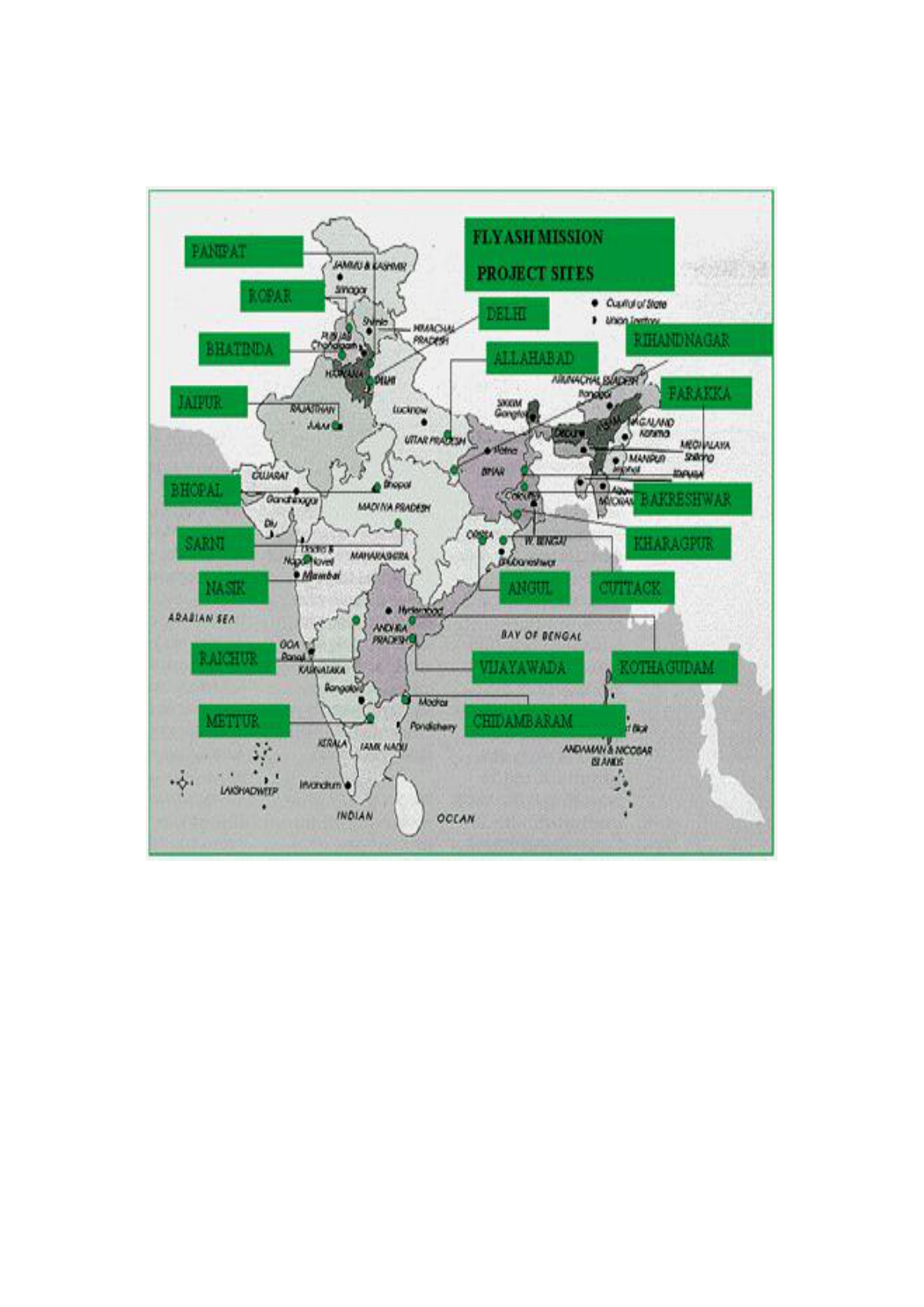
Fly ash in India: Generation vis-à-vis Utilization and Global perspective 39
Figure 10: Fly ash Mission Project Sites [12]
Whatever the exact figure for the utilization of fly ash in India, a significant
proportion of fly ash remains untreated and that there is an urgent need for developing
new recycling methods for it. Current application data for fly ash utilization in India is
illustrated in Figure 12 and described in the following sections.

40 Surabhi
MAJOR TYPES OF UTILISATION
The most important utilization areas of fly ash are as follows :
Cement manufacturing :
The fly ash contains substantial percentage of silica, alumina and lime and can be
used as a partial replacement of Portland cement. The replacement rates normally run
between 20% to 30% but can be higher. Fly ash reacts as a pozzolan with the lime in
cement as it hydrates, creating more of the durable binder. As a result concrete made
with fly ash is stronger and more durable than traditional concrete made with Portland
cement. More over it is less susceptible to chemical attack and hence suitable for
coastal atmosphere [13,14]
Filling of low lying area:
The fly ash especially bottom ash can be suitably utilized for filling low lying areas
over which future construction could be carried out. It can be also used for
reclamation of sea. If reclamation is judiciously implemented a huge quantity of fly
ash can be used for reclamation of land from sea especially in coastal areas like
Paradeep, Puri, Balasore, Astaranga, Gopalpur etc.
Construction of road and embankment:
Fly ash is a lightweight material. Therefore it undergoes lesser settlement and hence
can be used for embankment construction over weak substrate such as alluvial clay or
silt where excessive weight could cause failure. Due to its low compressibility it can
also be used for road construction as a sub grade material [15]
Fly ash brick :
Fly ash can be used for manufacturing of bricks used for building construction. These
bricks are light in weight and stronger than common burnt clay bricks available in our
state. Fly ash can also be used for manufacturing of pavement blocks/tiles normally
used for laying hard, durable and attractive flooring in the courtyards, pavements,
walkways, car parking etc. The use of fly ash for manufacturing of bricks and
pavement tiles will help in preserving land area dug out for clay brick manufacturing,

Fly ash in India: Generation vis-à-vis Utilization and Global perspective 41
prevent soil erosion and reduction in fire wood consumption which cause
deforestation [16]
Ash pond dyke raising:
The ash produced in power plants are disposed off in ash pond in slurry form. Due to
land constraints the dykes of ash pond are raised in stages. The ash from ash pond is
generally used for raising this dyke which in turn saves the borrow material. With
proper drainage arrangement and slope stability the fly ash could be a suitable
material for dyke construction in ash pond[17].
Agriculture:
Since fly ash contains micronutrients like phosphorus, potassium and calcium,
improves water holding capacity and soil aeration, it can be suitably used in
agriculture sector to improve crop yield [18,19,20,21]. Fly ash can also reclaim saline
alkali soil resulting in saving of gypsum.
The govt. needs to frame stringent policies to encourage use of fly ash in road and
embankment construction and reclamation of sea in coastal states of the country. The
govt. should also explore the possibility of use of fly ash in waste water and saline
water treatment.The unburnt carbon recovered from fly ash can be used a
adsorbent[22].
Last but not the least active participation of general public, non government
organization, Research organizations in effective utilization of fly ash is also required
in mitigating the challenge posed by increased fly ash generation in the country in
near future. Several possible uses of fly ash is summarized in following figure 13.
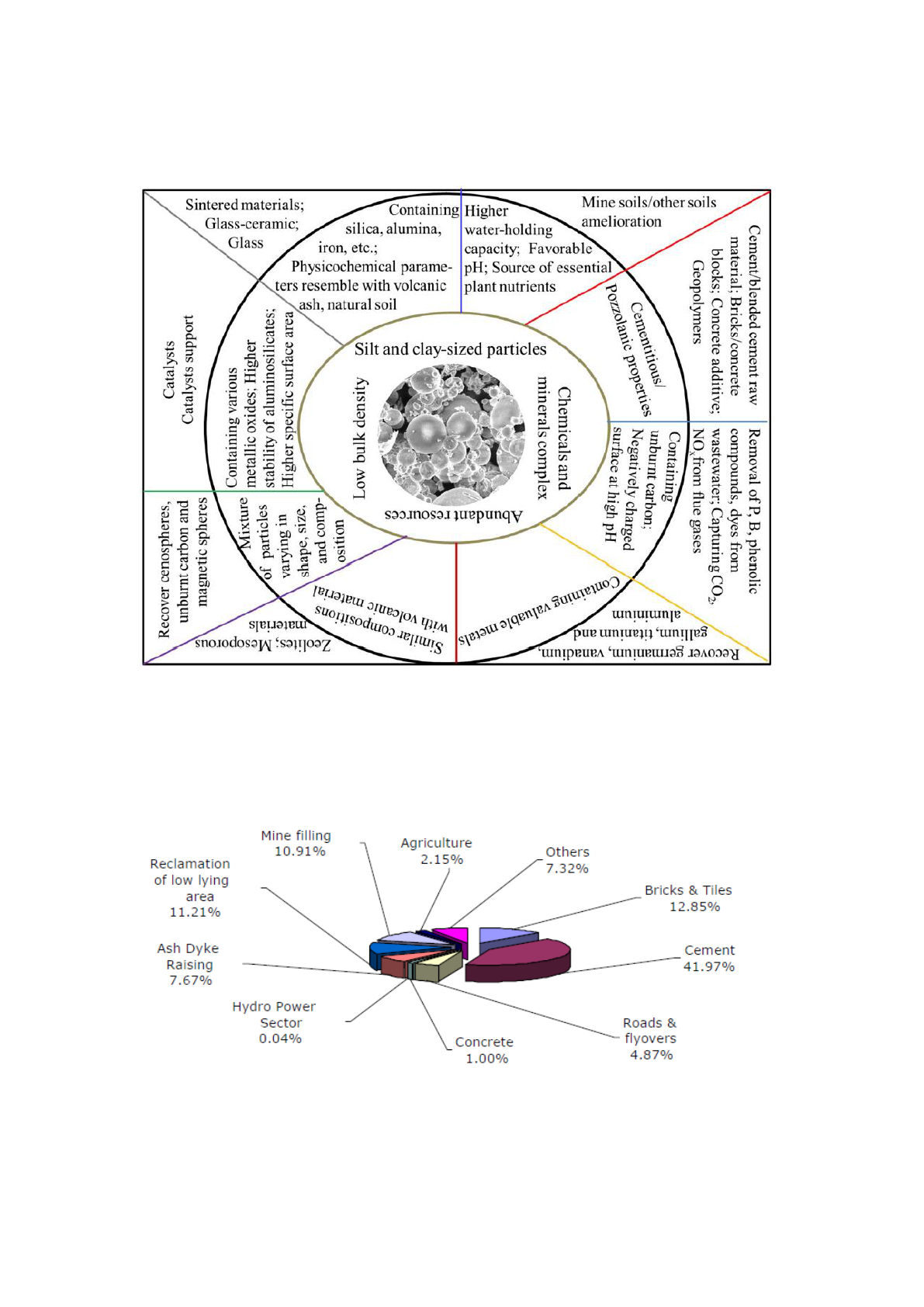
42 Surabhi
Figure 11: Various Possible utilization of fly ash[6]
CEA has shown the report explaining the mode of fly ash utilization in first half of
2015-16.
Figure 12: Mode of Fly Ash Utilisation in first half of 2015-16 [23]

Fly ash in India: Generation vis-à-vis Utilization and Global perspective 43
Fly ash generation & utilization data for the Year 2014-15 (April, 2014 to March,
2015) has been given from 145 (One hundred forty five coal/lignite based thermal
power stations) of various power utilities in the country. A brief summary of status is
given in Table-1below:
TABLE 1: Summary Of Fly Ash Generation And Utilization During Year 2014-15
Description
1
st
Half year
2014-15
1
st
Half year
2015-16
Number of Thermal Power Stations from which
data was received
146
132
Installed capacity (MW)
1,33,709
1,30,429
Coal consumed (Million tons)
273
257
Fly Ash Generation (Million tons)
92
84
Fly Ash Utilization (Million tons)
49
47
Percentage Utilization
53
56
Percentage Average Ash Content (%)
33.65
33.23
Central Electricity Authority has been monitoring since 1996-1997the fly ash
generation and its utilization at coal/lignite based thermal power stations in the
country. Based on data of fly ash generation and utilization received from Thermal
Power Stations/Power Utilities since 1996-97, the progressive fly ash generation and
its utilization for the period from 1996-97 to 2014-15 is given in figure below.
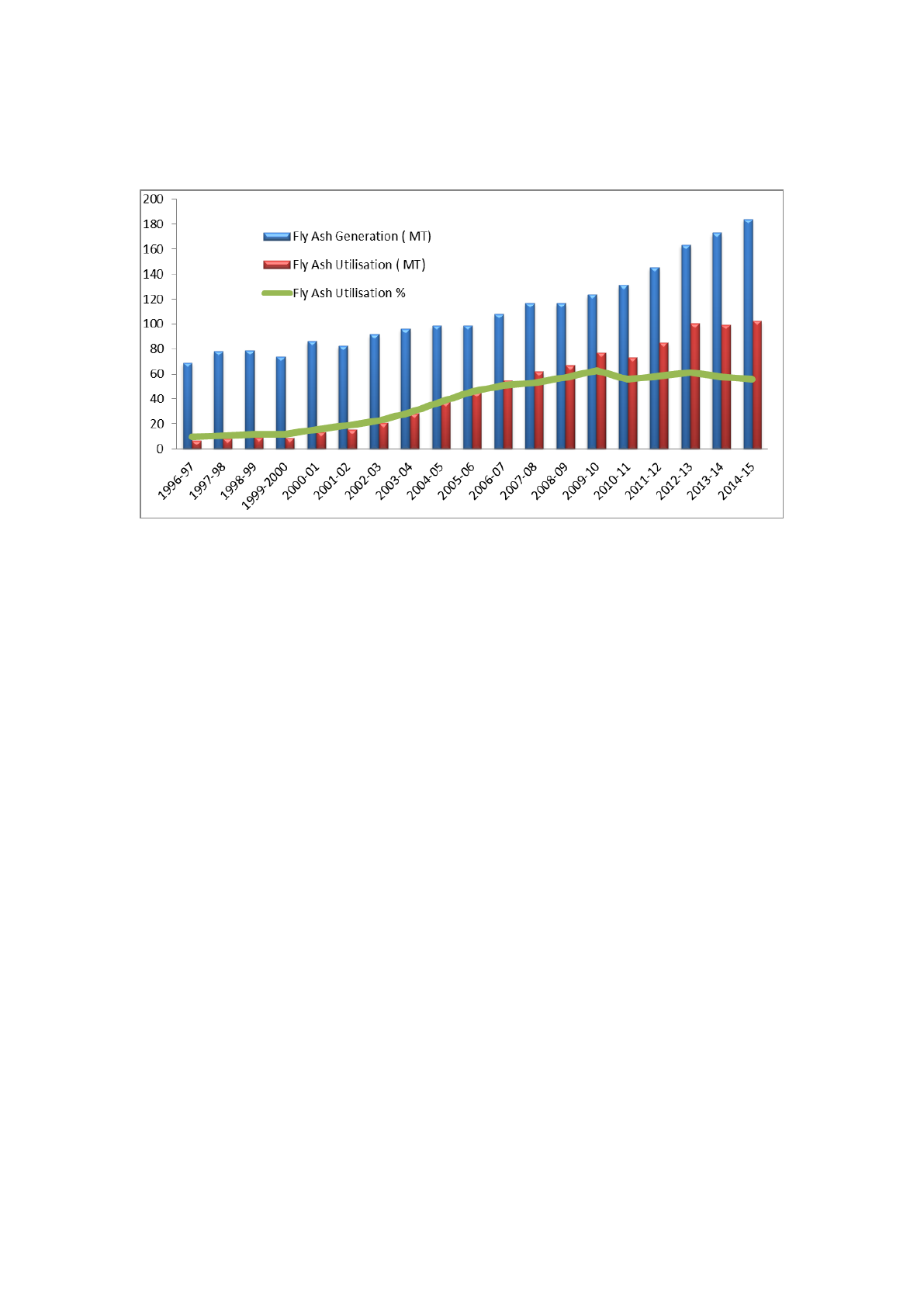
44 Surabhi
Figure 13: Fly Ash Generation and Utilization During The Period From 1996-97 To
2014-15
CHEMICAL CHARACTERISTICS OF INDIAN FLY ASH
The Indian low-lime fly ashes are characterized by relatively higher concentration of
SiO
2
and Al
2
O
3
and lower contents of Fe
2
O
3
. This implies higher fusion temperature
for these fly ashes and, consequently, the chances of lower glass formation, if the ash
is not subjected to relatively high temperature[24].
While in the low-calcium fly ashes the silica content is almost double of the alumina
content, in the high-calcium fly ashes the content of these two oxides is by and large
comparable or close to each other. The iron oxide context in the high-lime fly ash is
significantly higher than in the low-lime variety.
Studies involving sieving, sink-float [25] and magnetic separation, carried out to
study the heterogeneity of fly ashes, revealed that the variability of composition is
more in the high-lime fly ashes[26]. The unburnt carbon present in fly ash can be
recovcered by froth flotation or oil separation method [27].
A study has been conducted to classify the oxide compositions of fly ashes using
radial basis function neural network [28].

Fly ash in India: Generation vis-à-vis Utilization and Global perspective 45
COMPOSITION OF FLY ASH
It is widely known that the reactivity of fly ashes is dependent on their glass content
and other mineral phases present. It has been observed that the Indian fly ashes are
more crystalline than those obtained in other countries, the glass content ranging from
47.0 to 60.9 percent [29]. The network theory of glass formation [30] provides a
theoretical basis to explain the relatively poorer glass content in the Indian fly ashes.
Since the ratio of network formers (SiO
2
+ Al
2
O
3
+ Fe
2
O
3
) to network modifiers
(Na
2
O + K
2
O + CaO + MgO) in the Indian fly ashes is very high and imbalanced, the
glass content is low.
Depending upon the source and makeup of the coal being burnt, the composition of
fly ash and bottom ash vary considerably. Fly ash includes substantial amounts of
silicon dioxide and calcium oxide which are the main ingredients of many coal
bearing rocks[31] . Coal Bituminous coals, sub-bituminous and lignite coals from
different mines are substantially different from each other in the combustion process
[32].
Coal blending is now used for operational and financial benefits. This results in a
wide range of boiler and precipitator operating conditions. Precipitating fly ash from
difficult coals can be improved with conditioning systems. However, the furnace and
its associated equipment can still cause problems in the precipitator, particularly coal
mills, burners, and air pre heaters. The operation of coal burners, together with the
setting of the coal mills and their classifiers, affects the percentage of unburned
carbon(UBC) in the fly ash. The use of Low NOx burners increases this percentage,
and causes re-entrainment and increased sparking in the precipitator. Further, the UBC
tends to absorb SO
3
, which in turn increases the fly ash resistivity[33]
Contaminated constituents of fly ash depend upon the specific coal, but may include
one or more of the following elements in quantities or trace amounts to varying
percentages: Arsenic, molybdenum, selenium, cadmium, boron, chromium, lead,
mangnesium.

46 Surabhi
Table 2: Normal Range Of Chemical Composition For Fly Ash Produced From
Different Coal Types (Expressed As Percent By Weight).
Component
Bituminous
Sub bituminous
Lignite
Silicon dioxide,SiO2
20-60
40-60
15-45
Aluminium oxide,Al2O3
5-35
20-30
10-25
Iron oxide,Fe2O3
10-40
4-10
4-15
Calcium oxide,CaO
1-12
5-30
15-40
Magnesium oxide,MgO
0-5
1-6
3-10
Sulphur Trioxide,SO3
0-4
0-2
0-10
Sodium Carbonate,Na2O
0-4
0-2
0-6
Potassium oxide,K2O
0-3
0-4
0-4
It is known that the fly ash is separated from the gases generally with the help of
multi-field electrostatic separators and the specific surface areas of the flyashes
collected typically vary from about 250m
2
/kg to 850 m
2
/kg. Since the final collection
hopper contains materials of all the fields, the specific surface areas of the mixed fly
ashes as received at the user end are on the coarser side and quite variable [34].
For applications in cement and concrete one of the important quality tests is to check
their lime reactivity potential under standard test conditions [35].

Fly ash in India: Generation vis-à-vis Utilization and Global perspective 47
Table 3: Specification of the Indian Low-lime FlyAsh vis-à-vis US/European
Standards
Parameters
ASTM C-618
EN 450
IS 3812
SiO2 per cent, min
---
---
35
Reactive SiO2, per cent, min
---
25
20
SiO2 + Al2O3 + Fe2O3, per cent, min
70
---
70
Total/reactive CaO per cent, max
---
10
10
Residue on 45 μm per cent, max
34
40
34
Blaine’s SSA, min, m2 / kg
---
---
320
Lime reactivity, N/mm2, min
---
---
4.5
Cement Reactivity, per cent, min
75
75
80
GOVERNMENT OF INDIA INITIATIVES ON FLY ASH
According to The Gazette of India dated JANUARY 27, 2016 , Ministry Of
Environment, Forests And Climate Change Notification, New Delhi, the 25
th
January, 2016. The coal or lignite based thermal power plants shall comply with the
above provision in addition to 100% utilization of fly ash generated by them before
31
st
December, 2017.
The coal or lignite based thermal power plants shall within a radius of three hundred
kilometers bear the entire cost of transportation of ash to the site of road construction
projects under Pradhan Mantri Gramin Sadak Yojna and asset creation programmes of
the Government involving construction of buildings, road, dams and embankments.
Ministry of Environment, Forests and Climate Change (MoEFCC) has revised norms
for fly ash usage and disposal by granting permission to use it for agriculture. The
ministry has also made it mandatory for power plants to give fly ash free of cost to
users within 300-kilometre-radius.

48 Surabhi
According to MoEFCC, the fly ash utilisation in the country was 57.63 per cent in
2014 as against 13.51 per cent in 1999. About 20,000 hectares of land resources can
be saved annually by effectively utilisation of fly ash in India.
CONCLUSION
The generation of coal fly ash is anticipated to increase for many more years, as a
result of the world's increasing reliance on coal-fired power generation.
Understanding the generation and characterizations provides a background and a basis
for the alternative uses of fly ash. This review has attempted to investigate the
production of fly ash at the global level and covers a wide range of applications to
understand the status of fly ash utilization.
The knowledge of the various ways to use fly ash, such as in the construction industry,
Agriculture,waste water treatment , is essential for better management of fly ash and
the reduction of environmental pollution. However, there are still some limitations for
current applications. The long-term effect of fly ash addition on field scale crop
productivity and soil properties needs to be investigated. Fly ash reutilization is
significant in the construction industry; however, some physical and engineering
properties are also required to meet the standards. To promote the usage of fly ash,
state and local governments should issue preferential policies that encourage its
recycling, such as the preferential purchase of recycled fly ash products and reduction
of the overall effective tax.
This may be summarized as;
1. Utilization of fly ash is 56.04% in the first half of 2015-2016, which is very
much behind the required target.
2. Areas having large prospective of fly ash utilization needs to be discovered for
inceasing the overall utilization of fly ash in India.
3. Technological advancement is required for collection, storage and disposal
facilities of fly ash so that fly ash in dry form could be made available to its
users.
4. The states and districs where TPPs are located needs to promote fly ash
utilization; construction of building/highways/roads/flyovers and other
infrastructure projects.

Fly ash in India: Generation vis-à-vis Utilization and Global perspective 49
5. The use of fly ash in the projects within a radius of 300km of any TPP as
mandated in MoEF and CC’s notification of 25th Jan,2016 has to be ensured
right from project formulation stage.
6. Utilization of fly ash in agriculture is below expectation because of presence
of heavy metal and radioactive elements in fly ash. Theses apprehensions are
mandatory to be addressed for increasing fly ash utilization.
7. There is need to encourage industry-institute interaction for enterpreneur
development,creating awareness and organizing training workshops.
REFERENCES
[1] World Oil Outlook , OPEC Secretariat background paper, 15th International
Energy Forum Ministerial , Algiers, Algeria, 26th – 28th September, 2016
[2] Mehta, 1993- international conference on the area of fly ash, silica fumes,
slag & other mineral by products, ACI SP-79, American concrete Institute,
Detroite, pp. 1-48
[3] http://www.credenceresearch.com/report/fly-ash-market
[4] ASTM C618, Annual bool of ASTM standard volume 4.02, ASTM
International
[5] Nath, P. Sarkar, P., 2011, Effect of fly ash on durability properties of high
strength of high strength concrete, Procedia E ng. 14, 1149-1156
[6] Tensing,2011, “Grenner Building material with fly ash”, Asian journal of
civil engineering(Building and Housing)., Vol 12, No. 1, pp 87-105
[7] Clarke L B. Utilization Options for Coal Use Residues: An International
Overview. Proceedings of the Tenth International Ash Use Symposium,
ACAA, Orlando, Florida, EPRI Report No. TR-101774, January (1993), 2,
66-1 to 66-14
[8] Manz O E, Faber J H, Takagi H. Worldwide Production of Fly Ash and
Utilization in Concrete. Proceedings of the Third International Conference on
the Use of Fly Ash, Silica Fume, Slag and Natural Pozzolans in Concrete,
Supplementary Papers, Compiled by Mohamad Alasali, Trondheim, Norway,
(1989), 1-15.
[9] Manz O E. Worldwide Production of Coal Ash and Utilization in Concrete
and Other Products. Proceedings of the Tenth International Ash Use
Symposium, ACAA, Orlando, Florida, January (1993), 2, 64-1 to 64-12.

50 Surabhi
[10] Lin, B., Cerato, A.B., Madden, A.S., & Elwood Madden, M.E. (2013). Effect
of Fly Ash on the Behavior of Expansive Soils: Microscopic Analysis.
Environmental & Engineering Geoscience, 19(1), 85–94.
[11] Z.T. Yao et al.,2015, “ A comprehensive review on the application of coal fly
ash”, Earth-Science Reviews 141, 105–121
[12] www.tifac.org.in, Fly ash Mission, Technology Information Forecasting &
Assessment Council (TIFAC), Department of Science & Technology,
Ministry of Science & Technology, Government of India, Technology
Bhawan, New Delhi
[13] Dhadse, P. Kumari, L.J. Bhagia, 2008“ Fly ash characterization, utilization &
Government intiatives in India- a review, J Sci Ind Res. 67, pp 11-18
[14] U. Bhattarcharjee, T. C. Kandpal,2002, “ Potential of fly ash utilization in
India, Energy, 27, pp. 151-166
[15] Lentinen P,2001, Fly ash mixtures as flexible structural material for low
volume roads, Finnra reports 70/2001
[16] Surabhi, Udayabhanu G., Nikkam Suresh, “Removal of unburnt carbon from
fly ash to use it as an adsorbent”,Pollution Research 34 (4),2015, 687-692
[17] Sinha S N & Agarwal MK,1999, “ Fly ash; A new resource material cited in
fly ash disposal and deposition; Beyond 2000 AD, edited by U Dayal et al
( Narosa Publishing House, New Delhi) 70-75
[18] A. C. Chang, L.J.Lund, A.L. Page, et.al., 1977,“ Physical properties of Fly
ash amended soils, J Environ Qual, 6, pp. 267-270
[19] Ram, L.C., Srivastava, N.K., jha, S.K., Sinha, A.K., Masl,R.E., Selvi,
V.A.,2007b, “ Management of Lignite Fly ash for improving soil fertility &
crop productivity”, Environ. Management, 10,438-452
[20] Ram, L.C., Srivastava, N.K., Tripathi, R. C., Thakur, S.K., Sinha, A.K., Jha,
S.K. Masto, R.E., Mitra, S.,2007 a, “ Leaching behavior of lignite Fly ash
with column tests, Environ. Geol. 51, 1119-1132
[21] Pandey, V. C., Singh, N., 2010, Impact of fly ash incorporation in soil
system”, Agaric. Ecosyst. Environ. 136, 16-27
[22] Surabhi, Anil Kumar Chaudhary, “A study on the utilization of fly ash in
concrete”, ESAIJ, 10(2), 2015,41-45
[23] The Gazette of India dated JANUARY 27, 2016 , MINISTRY OF
ENVIRONMENT, FORESTS AND CLIMATE CHANGE NOTIFICATION,
New Delhi, the 25th January, 2016

Fly ash in India: Generation vis-à-vis Utilization and Global perspective 51
[24] Chatterjee K. Anjan, 2010, Second International Conference on sustainable
construction material & Technologies, June 28- June 30, Coventry University
and the University of Wisconsin Milwankee, centre for By- products
Utilization, ISBN 978-1-4507-1490-7
[25] Surabhi, Udayabhanu G., Nikkam Suresh, “Recovery of Carbonaceous
materials from Bokaro Thermal Power Plant Fly Ash by Froth Floatation”,
Proceedings of the International Seminar on Mineral Processing Technology,
2005,The McGraw-Hills Companies,pp.333-340
[26] Das, S.K. and Yudhbir (2003), “Chemistry and Mineralogy of Some Indian
Fly Ashes”, The Indian Concrete Journal, September, 1491 – 1494.
[27] Surabhi, Udayabhanu G., Nikkam Suresh, “Methodologies for Recovery of
Carbonaceous Material from Coal Combustion Byproducts –Powder
Processing and Technology, Trans-Tech Publication (Germany), 2004,pp.1-8.
[28] Nataraj, M.C., Jayaram, M.A. and Ravikumar, C.N.(2006),“Group-indexing
Fly Ashes through Radial Basis Function Network”, The Indian Concrete
Journal, July, 39 – 45.
[29] Fournier, B., Lu, D., Charland, J.P, and Li, J. (2004), “Evaluation of Indian
Fly Ashes for Use in HVFA Concrete, Part 1: Characterization”, The Indian
Concrete Journal, November, 22-30.
[30] Zacchariassen, W.J. (1932), “The Atomic Arrangement in Glass”, J. Am.
Ceram. Soc., 54, 3841 – 3951
[31] Surabhi, Udayabhanu G., Nikkam Suresh, “Characterization of Unburnt
Carbon Recovered from Fly Ash by Froth Flotation”, Proceedings of the
international seminar on Mineral Processing Technology, 2006, Chennai,
India, pp. 128-133.
[32] Md. Ghazali, Prof. O.P. Kaushal, 2015,” Characteristics of fly ash from
thermal power plants and its management along with settling pond design”,
vol-1,issue-4, 24-32
[33] Surabhi, Udayabhanu G., Nikkam Suresh, “Characterization and
Beneficiation of carbonaceous material in Indian fly ash”, Journal of Indian
Chemical Society, vol.91, 2014 January,73-80
[34] Chatterjee, A.K. (2008), “Enhancing the Potential of Industrial use of the
Indian Fly Ashes Through Mechano-Chemical Activation – Prospects and
Problems”, International Conference on Mechano-Chemistry and Mechanical
Alloys, National Metallurgical Laboratory, Jamshedpur, India.

52 Surabhi
[35] Mullick, A.K. (2005), “Use of Fly Ash in Structural Concrete : Part 1 –
Why ?”, The Indian Concrete Journal, May, 13–22.
